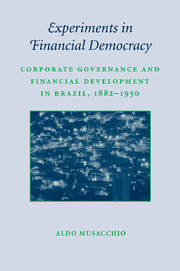 Experiments in Financial Democracy
Experiments in Financial Democracy Published online by Cambridge University Press: 30 January 2010
The degree to which shareholder protections mattered in practice to smaller investors should be reflected in tangible outcomes such as low levels of concentration in ownership and control in large Brazilian corporations. Ownership concentration is a good indication of the state of shareholder protections for at least two reasons. One, smaller investors unsure of the degree to which they are protected against the abuses of managers or other shareholders would be unlikely to participate actively in equity markets. Two, in the presence of weak shareholder protections there would be little to stop managers from pilfering company resources. Ownership concentration would compensate for inadequate shareholder protections because large shareholders with large blocks of votes would have more incentive to monitor managers and the power to dismiss and name new ones to replace any who committed abuses.
This chapter uses data on ownership concentration for a sample of some of the largest Brazilian corporations between 1890 and 1940 to show that corporations with more protective shareholder rights in their bylaws had lower concentration of ownership than the average company. Statistical analysis of the data on ownership concentration reveals that in companies that limited the power of large shareholders through voting provisions, such as maximum votes, the concentration of ownership and control rights (votes) was significantly lower than for the average Brazilian company.
The fact that bylaws protective of small shareholders might have reduced ownership concentration in some of the largest corporations in Brazil helps to explain why there was lower concentration of voting power in the hands of large shareholders of publicly traded corporations in the past than today.
To save this book to your Kindle, first ensure [email protected] is added to your Approved Personal Document E-mail List under your Personal Document Settings on the Manage Your Content and Devices page of your Amazon account. Then enter the ‘name’ part of your Kindle email address below. Find out more about saving to your Kindle.
Note you can select to save to either the @free.kindle.com or @kindle.com variations. ‘@free.kindle.com’ emails are free but can only be saved to your device when it is connected to wi-fi. ‘@kindle.com’ emails can be delivered even when you are not connected to wi-fi, but note that service fees apply.
Find out more about the Kindle Personal Document Service.
To save content items to your account, please confirm that you agree to abide by our usage policies. If this is the first time you use this feature, you will be asked to authorise Cambridge Core to connect with your account. Find out more about saving content to Dropbox.
To save content items to your account, please confirm that you agree to abide by our usage policies. If this is the first time you use this feature, you will be asked to authorise Cambridge Core to connect with your account. Find out more about saving content to Google Drive.